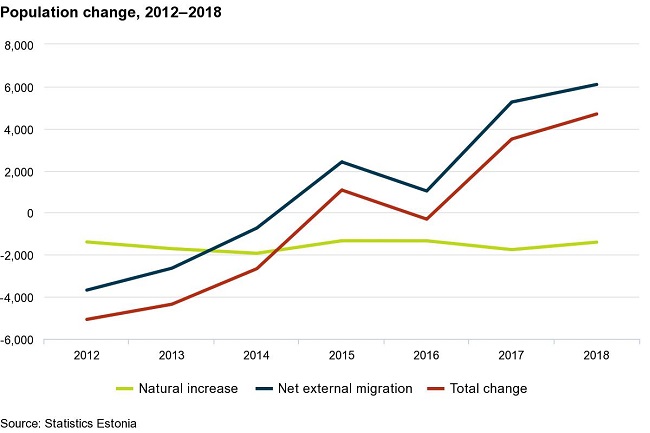Analytics, Demography, Estonia, Statistics
International Internet Magazine. Baltic States news & analytics
Sunday, 14.12.2025, 20:41
The population of Estonia increased in 2018
 Print version
Print versionhe population decreased by 1,400 due to negative natural increase (the number of deaths exceeded the number of births) and increased by 6,090 due to positive net migration (more persons immigrated to Estonia than emigrated). In total, the population of Estonia increased by nearly 0.4% in 2018.
More than 14,270 children were born in Estonia in 2018, which is 500 children more than the year before. An increase in the number of births in a situation where the number of women exiting active childbearing age (20–44) is larger than the number of women entering it indicates an increase in fertility rates.
In the case of births, also the number of births per woman can be considered. As there are more women in the second half of their active childbearing age than in the first half, the number of births of first children and its share in the total number of births has declined already for some time.
The birth of third and additional children is required for the natural recovery of the population; however, from the third child, the economic setback of families is greater than in the case of the first two children, and, in order to avoid this situation, some children may not be born. In the period of re-independence, fertility in Estonia has been significantly lower than the replacement level. In recent years, however, the state has considerably raised the allowances for families with three and more children to support births. This has contributed to an increase in the number of births of third children – in 2018, compared to 2017, the number of third children born increased by more than 500, which signifies an increase of more than 20%. Third children accounted for a fifth of all children born in 2018.
There were 15,670 deaths in 2018. The number of deaths has remained in the range of 15,200–15,800 in recent years. As life expectancy continues to increase, the share of older people increases in the population.
13,030 persons immigrated to Estonia and 6,940 persons emigrated from Estonia in 2018. Migration statistics are most difficult to estimate based on preliminary data, as Statistics Estonia supplements migration figures with data from other registers, and later adds also unregistered migration according to the rules for determining permanent residents (residency index). Reaching the final result is more complicated compared to other events, both technically and methodologically, and can significantly increase migration flows. Emigration increases mainly due to unregistered leaving of Estonian citizens. Immigration increases mainly due to their return migration, which is not recorded in the population register, as the prior leaving was not registered. Compared to immigration, emigration is less registered, and therefore, emigration increases presumably more than immigration in the revised population number – it can be assumed that net migration is somewhat smaller in the results published in May.









 «The Baltic Course» Is Sold and Stays in Business!
«The Baltic Course» Is Sold and Stays in Business!

